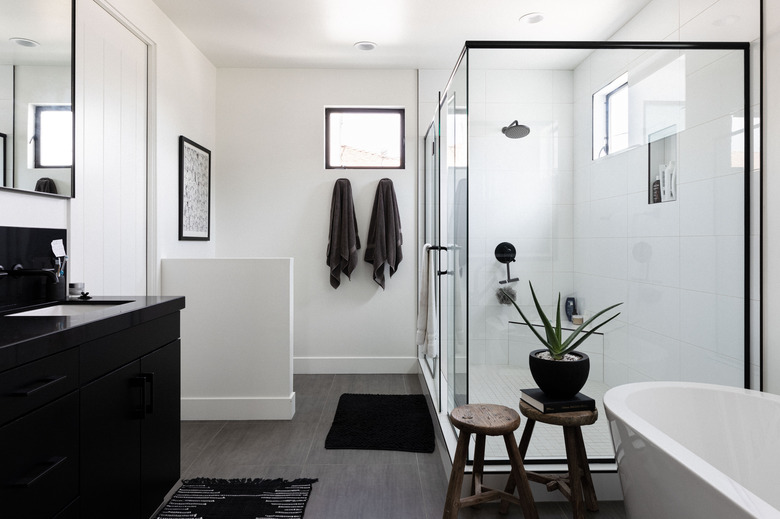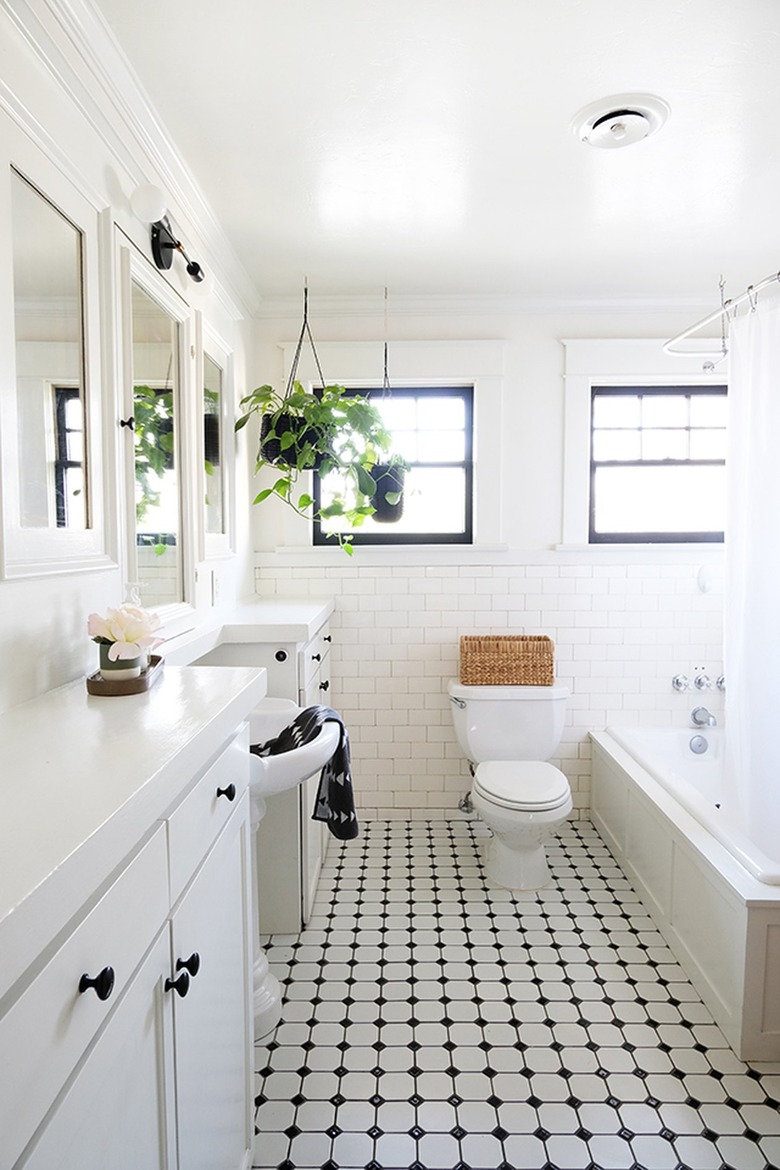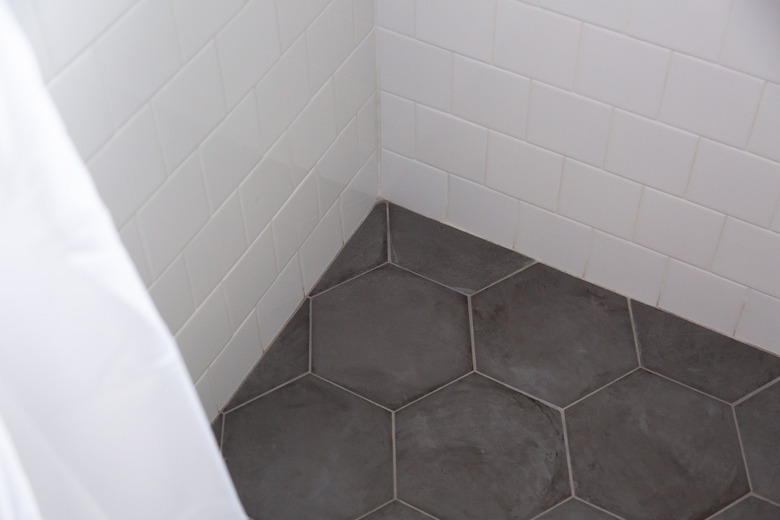Best Types Of Tile For Bathroom Floors
We may receive a commission on purchases made from links.
When you began shopping for bathroom flooring, it probably didn't take you long to choose tile. It may take you a bit longer, however, to sort through all the different types of bathroom tiles from which you can choose. The perfect tile for your project will depend on your style, the size of your bathroom and the way you choose to minimize the risk of falls in your bathroom.
Understanding Slip Resistant Tile
Understanding Slip Resistant Tile
To help keep you safe in the bathroom, the Ceramic Tile Institute of America developed testing protocols to measure the slipperiness of tiles. This rating, called the coefficient of friction (COF), measures the amount of friction between a human foot and the tile surface. The higher the COF, the greater the amount of friction and the less likely you are to slip.
According to the experts at BuildDirect, a COF of 0.60 or higher means the floor is slip-resistant, and falls are unlikely. This COF also meets both the Occupational Safety and Health Administration (OSHA) and Americans with Disabilities Act (ADA) tile floor requirements. A COF between 0.50 and 0.59 indicates a tile floor that is safe for most people but isn't technically labeled as slip-resistant. At this COF, a floor will meet OSHA requirements but not those of the ADA.
A COF below 0.50 indicates a tile floor that is potentially unsafe, especially a bathroom or kitchen floor where water could be present. Ideally, you should choose tiles with a COF of 0.60 or higher for your bathroom floor remodel.
Understanding Tile Size
Understanding Tile Size
When choosing tiles for your bathroom floor, you'll find almost as many sizes as you will types of bathroom tiles. Your choice will have both a practical and visual impact on your finished floor. Generally, large tiles work well in a small bathroom, creating the feel of more space. For an even larger feel, you can lay the tile in a diagonal pattern. Large tiles also mean fewer grout lines, which can make a space look cluttered and can make it harder to keep the floor clean.
Small tiles have their benefits, however. In a large space, smaller tiles can make the room feel a bit smaller and cozier. Smaller tiles require much more grout, but a light tile and a dark grout can create an interesting effect on the floor and become part of the design. More grout also means more grip and a lower probability of slipping when the floor is wet. Several small tiles are less slippery under wet feet than one large tile.
If you're having trouble choosing between large and small tiles, consider both. You may, for example, choose large tile for most of the bathroom floor but tile your shower floor with small tile to enhance slip resistance.
Glazed vs. Unglazed Bathroom Tile
Glazed vs. Unglazed Bathroom Tile
If you've decided on porcelain or ceramic tile, you'll need to decide whether you would like it glazed or unglazed. Both types of tile start out the same, but glazed tiles go through an extra firing process that adds a thin, glassy layer to the top of the tile.
When left unglazed, tiles have a more textured finish that offers superior slip resistance but leaves them susceptible to stains. They're much more forgiving than their glazed counterparts when hiding scratches, however. Unglazed tiles are only available in natural earth tones, which limits your color selection.
Because the color is added with the glaze, glazed tiles come in just about any color you can imagine. Their protective glassy coating makes them easy to clean and stain-resistant, but they will show scratches. Glazed tiles are more slippery when wet than unglazed tiles, but you can work around this. Choose glazed tiles in a matte or satin finish rather than a high-gloss option and consider using rubber-backed bath mats outside the tub or shower to help prevent falls. In any case, don't try to guess about the slip resistance of a tile; refer to the COF rating for a definitive answer.
Common Types of Bathroom Tiles
Common Types of Bathroom Tiles
Two of the most popular types of bathroom tile are ceramic and porcelain. These two tiles are very similar, but there are important differences between them. As Real Homes explains, both tiles are made by firing natural clay. Ceramic is left in its natural state, however, while fine sand is added to porcelain. This sand makes the porcelain denser and less porous than ceramic.
Both ceramic and porcelain tile are suitable for indoor use and can work on bathroom floors. Porcelain is more suited to high-traffic areas, though, and less likely to shatter if a heavy object falls on it. Unlike ceramic, porcelain is also colored all the way through: chip a blue porcelain tile and it will be blue underneath. Do the same with a ceramic tile and you'll have a white spot where the chip is. Because it is denser, porcelain is also a bit more water-resistant than ceramic, which is a desirable trait in a bathroom.
Given its many positive traits, porcelain would seem to have all of the advantages over ceramic. Glazed ceramic comes in more colors and patterns than porcelain, however, and it's easier to cut if your bathroom floor is going to be a DIY project. It's also less expensive than porcelain. Porcelain is generally a better choice for flooring, but you can get away with ceramic when you have a tight budget and don't need your floor to stand up to kids or pets.
Natural Stone Tiles
Natural Stone Tiles
When considering the types of bathroom tiles for your floor, don't overlook natural stone. Stone is beautiful and durable, but it's porous and will require sealing to avoid staining. The biggest advantage of stone is that it creates a unique look since no two pieces of stone are identical. However, stone can get expensive. It works best when you have a big budget or a small floor.
Marble tiles are lovely and are considered high end, but the wrong cleaners will cause permanent etching. Granite is tougher than marble and is easier to live with, but it too requires sealing and is very heavy. You'll need a beefy subfloor to support the weight of granite. Travertine is a softer stone and feels better on bare feet than other stone floors. It's extremely porous, however, and requires diligent sealing and cleaning or it will show wear.
Perhaps the best stone for bathroom floors is slate. Slate comes in dark, rustic colors and is much more stain-resistant than other stones. Slate also handles water well and doesn't get as slippery as polished stones like marble. It's expensive, though, and professional installation is a must. Slate forms in layers, so uneven installation can result in chipping and uneven floors.
The Importance of Floor Tile Upkeep
The Importance of Floor Tile Upkeep
It's important to clean up spills in the bathroom promptly and keep the floor as dry as you can. Even textured tiles with a high COF rating can lose some of their grip if the nooks and crannies fill with dust and dirt.
To keep things clean, sweep your floor every few days. When it's time for a deeper cleaning, mop the floor with a mild cleanser and a chamois mop. Don't use a sponge mop, as these push water into your grout lines rather than absorbing it. They also tend to spread dirt around rather than lifting it out.
You'll also need to clean the grout between your floor tiles from time to time. You can seal the grout to make its porous surface more stain-resistant, but it will still need a little TLC once in a while. To keep it clean, mix together equal parts hydrogen peroxide and baking soda. Apply it to your grout, let it sit for 10 or 15 minutes and then scrub the grout with a small brush. You can also use bleach if your grout is white, but never do so when cleaning colored grout.
Bathroom Floor Tile to Avoid
Bathroom Floor Tile to Avoid
There are some types of bathroom tiles that, although perhaps workable for a backsplash or shower walls, just aren't appropriate for your floor. One is glass tile. Glass tiles can be quite stunning and make excellent wall or backsplash tiles. Their glossy surface is incredibly slippery and completely inappropriate for flooring, however. If a tile specifies that it's for use on walls, don't try to use it on your floor.
Linoleum tile should also be avoided. It's cheap and easy to install, but there's no grout to hold it all together. No matter how well you lay the tiles, there will always be seams between them where water can get in and rot the subfloor or start to lift the tile.
The internet is rife with websites that extol the virtues of cork tiles in the bathroom, but don't be fooled. Cork tiles are essentially giant sponges. It takes just one bathtub overflow or bad plumbing leak to completely ruin the floor. Cork also suffers linoleum's limitation in that there are always seams in cork tile floors through which water can creep. Because it is soft, dropping a pair of scissors or another sharp object can put a permanent ding in the floor as well, and even a dog nail or cat claw can mar the floor.
References
- BuildDirect: Skid Resistance Scales for Tile Flooring
- Real Homes: How to Choose Ceramic and Porcelain Floor Tiles
- International Assocaition of Certified Home inspectors: Cork Floor Inspection
- Angie's List: 5 Bathroom Flooring Ideas to Avoid
- Express Flooring: Slate Tile Flooring – Characteristics, Pros and Cons
- Urban Customs Flooring & Remodeling: Stone Flooring Pros & Cons
- The Home Depot: Porcelain vs. Ceramic Tiles
- BuildDirect: The Characteristics Of Glazed And Unglazed Tile
- Real Homes: How to Choose Tiles for a Small Bathroom
- International Association of Certified Home Inspectors: Inspecting Slip-Resistant Flooring in Commercial Buildings


